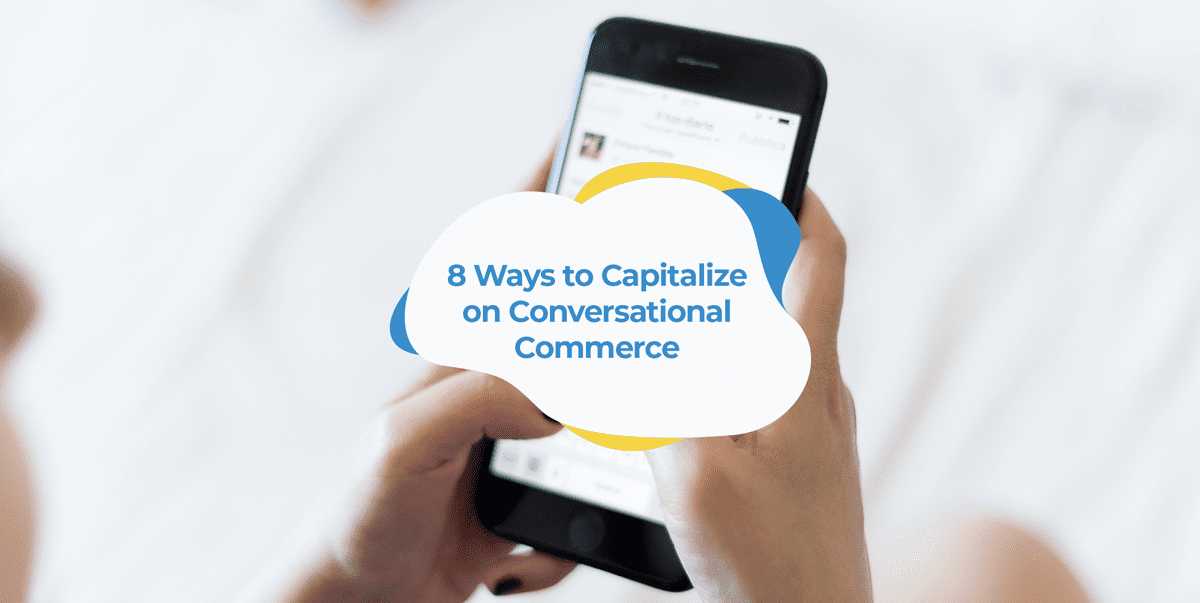A growing number of Americans are pulling out their smartphones to chat, make plans, and share media on messaging apps, resulting in an exchange of more than 41 million mobile messages worldwide in a single online minute.
As people opt for the immediacy of communicating through apps, like Facebook Messenger, WhatsApp, and Snapchat, forward-thinking businesses are meeting them there, resulting in a marketing strategy known as conversational commerce.
Think of conversational commerce as a one-on-one dialogue with a customer over digital messaging. It melds our growing fondness for the technology with highly responsive customer service, enabling businesses to answer questions, solve problems, recommend products, and even make sales.
In this guide, we’ll look at the potential of conversational commerce as a new sales channel, what it looks like in practice, and how businesses of all sizes can implement this strategy to enhance customer relationships and conversion.
What is Conversational Commerce?
Conversational commerce refers to the interaction between a customer and a business through digital messaging and voice-assisted technology. It can take the form of a live chat with a customer service representative, an automated chatbot, or a combination of both. Some examples of conversational commerce tools include Tidio, Livechat.com, Drift, and HubSpot Live Chat.
Conversational commerce is a fast and easy form of communication that focuses on being ready to help whenever needed. Customers can message a business and receive an instant response instead of sitting on hold on the phone or using online forms and waiting for a reply.
Take a look at how personal audio brand Skullcandy uses chat to answer a question about product returns and initiate the return process.
Conversational Commerce at Work
While ecommerce provides convenient shopping 24/7, most customers must navigate online stores on their own, searching inventory for the right product and finding return policy information. A fine-tuned website makes this experience easier, but conversational commerce, when optimized, takes the customer by the hand and guides them through the purchasing journey. Customers can learn about products, get assistance, and even complete purchases with a few quick taps.
This strategy can best be compared to the face-to-face interaction you receive in-store with a friendly sales associate. The presence of a chatbox on a website or Facebook page adds a personal, conversational touch that’s previously been lacking in a digital experience.
Here’s what conversational commerce looks like in practice:
- A customer messages a local bookstore for recommendations. After answering a few questions to help narrow down choices, the customer receives links to suggested products, saving them the time and effort of researching books online.
- A consumer adds a product to their shopping cart but has a shipping question. A quick query to live chat results in a satisfactory answer and the purchase is completed.
- A first-time visitor to a website like Sun50, a sun protective clothing retailer, is greeted by a friendly chatbot offering a promo code. After engaging in the chat, the customer provides an email address in exchange for a discount.
Businesses are starting to recognize the potential of automating conversations with customers on the digital platforms they most frequent. H&M helps customers with product recommendations on Kik. Chipotle enables customers to place and pay for orders through Facebook Messenger. Carrefour, a grocery chain, has linked its ecommerce platform to Google Assistant for voice-activated shopping.

Conversational Commerce Has Its Benefits for Sellers
Conversational commerce improves customer service by making your business more approachable. It also makes it easier to connect you to customers and keep them engaged with your business. Here are three ways you can use this tool to improve workflow efficiencies and build customer relationships.
1. Feedback is collected immediately.
To deliver superior customer service, you need to know what your customers think of their experience and what internal processes may need improvement. Using conversational commerce, you can send a quick message to buyers after their order has been delivered and ask them to rate their satisfaction. It also gives you the ability to know when customers are unhappy and to respond immediately.
Positive feedback can be used as social proof to help convert other customers. Nine out of 10 buyers read online reviews before they do business with a company, and 72% only purchase a product or do business with a company after they’ve confirmed others have had a good experience. Invite customers to submit a written or video testimonial, which can be done right from their smartphone, and put these glowing reviews to work for you.
2. Helps build customer loyalty.
Online sales of physical goods are expected to top more than $476 billion in the United States by 2024. This means there are a lot of consumers shopping online but also many businesses competing for their dollars.
Building customer loyalty involves more than delivering a stellar product and making a customer’s experience as smooth as possible. You also need to demonstrate to customers that their business is essential to you.
You can build a sense of trust by using a messaging system to respond quickly to inquiries, advise when items are back in stock, thank customers for orders, send tracking numbers, and check in to see how they’re enjoying their purchase.
You can also extend the relationship beyond the initial transaction. Reach out with a product recommendation customers might like based on their history or let them know about a new line. Trigger a VIP promotion after they spend a certain amount or offer an enticement if they haven’t shopped for a while.
3. Cost and time effective.
Digitally savvy customers love quick solutions to problems that don’t require them to switch to another means of communication. Seven out of 10 consumers prefer messaging to calling a support line, and 90% want a problem solved in less than 10 minutes.
While this may sound labor-intensive for your business, an automated bot can be programmed to provide efficient responses to repetitive customer service inquiries, like shipping times and costs mentioned in receipt or any invoice templates.
Chatbots are always accessible, can handle multiple inquiries at once, and enable you to direct staff resources to more complex tasks. Take a peek at how Skullcandy helps customers solve a common technical problem by linking to user guides and videos on a Facebook chat.
How to Use Conversational Commerce to Your Advantage
There are two main goals to conversational commerce: solving immediate consumer problems and building brand loyalty and increasing your customer retention rate. Here are some ways you can use conversational commerce and email marketing to strengthen essential customer relationships and boost sales over the long term.
1. Turn personalized suggestions into sales.
According to the National Retail Foundation, customers are most frustrated by the pre-purchase stage of the buying journey, which involves researching and choosing products. Businesses that can remove some of this friction have a considerable opportunity to set themselves apart from competitors.
In short, make your customer’s life easier. Use conversational commerce to do the legwork and reduce the effort customers need to put into purchasing. Once you’ve helped customers sift through product choices, all they need to do is click the purchase button — you’ve already proven to be the retailer that best understands their needs.
Businesses can also extend this relationship by reaching out to customers with follow-up email marketing. Consider offering additional recommendations and promotions based on conversations, purchases, and browsing history to build ongoing loyalty.
Sign-up to our newsletter and receive a free Calendar with all the most important key eCommerce dates that you shouldn’t miss in 2024
2. Offer unique deals directly to customers.
Special promotions can drive customers to action; in fact, more than 70% of consumers say that discounts influence their decisions to purchase online.
Check out how skincare brand Aria Glow greets new visitors to their website with an immediate $5 discount.
Offering a discount with an email subscription helps you build sales leads. If the visitor doesn’t convert on the initial visit to your site, you can follow up with an email offering a more significant promotion as a further enticement to purchase.
U.S. mobile users are often willing to receive sales messages directly on their phone if it offers them a financial benefit, creating a legitimate business reason to reach out to smartphone customers.
Consider an offer that creates a feeling of exclusivity or urgency to drive a response. Your digital messaging promotions can include mobile-only, flash, and friends & family sales.
3. Crowdsource for new product ideas.
Because conversational commerce creates a two-way dialogue, it’s a great platform for connecting with customers in new and dynamic ways. Customer engagement can be one of the keys to retaining customers.
Make use of surveys and polls and spark a conversation with your customers. You’re not only expressing an interest in their ideas, but you’re gathering first-hand information to deliver better customer service. Here are ways to get started:
- Conduct research on a particular issue. Ask customers what they’d change about a certain product or survey them about color options they’d like to see.
- Incorporate feedback in a fun and tangible way. A coffee shop might let customers suggest a flavor for a limited-time-only summer drink. A candle company might invite votes for a new scent.
- Ask customers for ideas of products they want you to stock. By interacting with your target audience, you can gain some meaningful insights into their needs.
4. Use conversational commerce to share content.
Another way to engage customers is by creating value-added content, like blog posts, tip-sheets, video demos, podcasts, and webinars. This type of marketing content can increase awareness of your brand, generate leads, and establish your business expertise.
A chatbot can be a great way to match relevant content to users. For example, if a customer has messaged a health food store about vitamins, the merchant can then send a link to an e-book on the same topic.
An occasional well-timed message delivering a piece of content can also be welcome if it offers value. Consider sending links to a video highlighting the latest fashion trends at the start of a season or gift guides as holiday shopping approaches.
5. Help define your brand image and voice.
Your brand’s voice is how you communicate with customers and differentiate from other companies. It extends beyond a logo or brand colors to the perceptions of your company and the values you represent.
Whether your voice is sophisticated, playful, conservative, or witty, it needs to be consistently presented each time you interact with the customer. Conversational commerce lets you take this a step further because you’re speaking directly to the customer using the voice.
Compare how Sun50 and All Things Vinyl use their brand voice when offering a discount code. Sun50 is direct and professional. All Things Vinyl uses an informal style with exclamation marks and emojis.
Regardless of your brand’s personality, your tone should always be personable and helpful when using conversational commerce. Take advantage of the informal nature of messaging to give your business a human face and establish one-on-one rapport with a customer.

6. Reduce your cart abandonment rates.
Cart abandonment occurs when a customer adds a product to their online shopping cart but leaves before completing their purchase. This can be for a variety of reasons: they were distracted, couldn’t find the answer to a question, or weren’t sure they wanted the product.
The good news is 35% of abandoned carts can be recovered by engaging customers with timely reminders, which can be a combination of cart recovery emails and messaging. These communications can prompt action by:
- Reminding customers there are items in the cart.
- Asking if they have questions.
- Offering a discount to complete the purchase.
- Providing the link to finish a purchase.
Your message should be concise and friendly and include a call to action. Here are some ideas:
- Do you need help with your [brand name] purchase? Click to speak to a service representative.
- Finish your [brand name] purchase today for free shipping!
Conclusion
Inspired by the growing popularity of online messaging, conversational commerce brings together businesses and customers using digital messaging or voice technology. It may take the form of a live chat, automated chatbot, or both, and complements other strategies, like email marketing and social media, to more fully engage digital consumers.
Brands use conversational commerce to deliver a personalized level of customer service to digital shoppers using their preferred method of communication. When optimized, it enables businesses to answer questions quickly, recommend products, offer discounts, request feedback, and convert customers all within a single channel.




